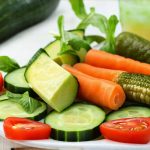The aftermath of a stomach bug – or even a particularly nasty bout of nausea – isn’t just about surviving the worst of it. It’s often followed by a period where your digestive system feels fragile, depleted, and incredibly sensitive. Many people mistakenly rush back to their normal diets, thinking they’re “over it,” only to find themselves revisiting unpleasant symptoms or prolonging the recovery process. This is because our gut needs time to heal and rebuild its microbial balance after being disrupted by illness, and simply resuming a regular diet can overwhelm its capacity. It’s akin to running a marathon while still recovering from an injury – you’re setting yourself up for setbacks.
The digestive system is a complex ecosystem, relying on a delicate interplay of enzymes, bacteria, and physical processes. When illness strikes, this ecosystem gets thrown into chaos. Inflammation increases, beneficial gut bacteria can be wiped out (or significantly reduced), and the lining of the intestine becomes irritated. Reintroducing foods too quickly – especially those that are difficult to digest or highly processed – forces a weakened system to work overtime, potentially exacerbating inflammation and hindering its natural restorative processes. Prioritizing gut rest and adopting a gentle eating approach is therefore paramount for a full and sustainable recovery, allowing the digestive tract time to repair itself and re-establish a healthy microbial community. If you’re struggling with rebuilding your gut after illness, consider learning about rebuilding gut flora.
The Importance of Gut Rest
Gut rest isn’t about starving yourself; it’s about strategically reducing the workload on your digestive system so it can focus on healing. Think of it as giving your gut a much-needed vacation. This means minimizing the types of foods you eat and opting for easily digestible options that require minimal effort to break down. The goal is to reduce inflammation, allow the intestinal lining to repair itself, and create an environment where beneficial bacteria can thrive once again. During this period, focusing on hydration is also crucial, as vomiting and diarrhea deplete fluids and electrolytes essential for optimal digestive function.
A key element of gut rest involves temporarily eliminating foods that are known irritants or difficult to digest. These include: – Fatty/fried foods – Spicy foods – Dairy products (for those sensitive) – Caffeine – Alcohol – Highly processed foods – anything with lots of additives or artificial ingredients. – Fiber-rich foods initially, gradually reintroducing them as tolerance increases. The length of the gut rest period varies depending on the severity of the illness and individual recovery rate, but typically ranges from 24 hours to several days. It’s about listening to your body and responding to its signals. When dealing with food poisoning or stomach flu, a recovery plan can be very helpful.
It’s also important to understand that “gut rest” doesn’t necessarily mean complete fasting for everyone. For some, a short period of clear liquid diet might be appropriate initially, followed by gradual reintroduction of bland foods. Others may benefit from continuing to eat small, easily digestible meals while avoiding trigger foods. The key is gentle and gradual. Trying to force yourself to eat when you’re not feeling up to it can actually prolong the recovery process.
Gentle Eating: Reintroducing Foods Slowly
Once the initial gut rest period has ended, it’s time to begin reintroducing foods – but slowly and strategically. This is where “gentle eating” comes into play. The aim is to identify which foods your system can tolerate without triggering symptoms. Start with the blandest, most easily digestible options available. Good starting points include: – Bananas – Rice (white rice is gentler than brown) – Applesauce – Toast – plain white toast is best – Broth (chicken or vegetable) These foods are low in fiber and fat, minimizing stress on the digestive system.
The reintroduction process should be methodical. Introduce one new food at a time, in small quantities, and monitor for any adverse reactions. Wait 24-48 hours before introducing another new food. If you experience symptoms like bloating, gas, diarrhea, or nausea after eating a particular food, remove it from your diet temporarily and try again later. This process helps pinpoint sensitivities and allows you to build a personalized dietary plan that supports your recovery. It’s also vital to avoid overeating, even with gentle foods; small, frequent meals are preferable to large portions. If you’ve recently experienced a stomach virus, reintroducing foods can be tricky but manageable with the right approach.
As tolerance increases, you can gradually expand your diet to include other easily digestible options like cooked vegetables (steamed carrots or green beans), lean protein (boiled chicken or fish), and simple carbohydrates (potatoes). Remember to prioritize whole, unprocessed foods whenever possible. Avoid rushing the process – it’s better to take things slowly and ensure a comfortable recovery than to re-trigger symptoms by introducing too many foods at once.
Identifying Your Trigger Foods
Understanding your individual trigger foods is critical for preventing future flare-ups and supporting long-term gut health. Food sensitivities can be highly personalized, meaning what bothers one person may not affect another. Keeping a food diary can be incredibly helpful in this process. Record everything you eat, along with any symptoms you experience afterwards. This will help you identify patterns and pinpoint foods that consistently cause problems.
Beyond obvious irritants like spicy or fatty foods, common trigger foods include dairy (especially for those with lactose intolerance), gluten (for those with sensitivities), artificial sweeteners, and certain vegetables (like broccoli or cauliflower) due to their high FODMAP content. FODMAPs are fermentable carbohydrates that can cause digestive distress in some individuals. If you suspect food sensitivities, consider exploring a low-FODMAP diet under the guidance of a healthcare professional. You may find it helpful to restore digestive balance during this time.
It’s also important to note that stress and anxiety can exacerbate digestive symptoms. Managing stress levels through techniques like meditation, yoga, or deep breathing exercises can play a significant role in improving gut health and reducing sensitivity.
The Role of Probiotics & Prebiotics
While gut rest focuses on minimizing stress on the digestive system, rebuilding the microbial balance is equally important for long-term recovery. This is where probiotics and prebiotics come into play. Probiotics are live microorganisms that benefit your gut health when consumed, while prebiotics are fibers that feed those beneficial bacteria.
Introducing probiotic-rich foods like yogurt (if tolerated), kefir, or fermented vegetables can help replenish the gut microbiome after it’s been depleted by illness. Probiotic supplements may also be considered, but it’s best to consult with a healthcare professional to determine the appropriate strain and dosage for your individual needs. Prebiotics found in foods like bananas, oats, and asparagus support the growth of beneficial bacteria, further enhancing gut health.
However, it’s important to introduce probiotics and prebiotics gradually, as they can sometimes cause temporary bloating or gas. Start with small amounts and monitor your body’s response. Remember that a diverse diet rich in whole foods is the foundation for a healthy microbiome. Rebuilding gut resilience after illness takes time and patience.
Staying Hydrated & Replenishing Electrolytes
Vomiting and diarrhea associated with stomach bugs can lead to significant fluid loss, resulting in dehydration and electrolyte imbalances. Dehydration can worsen digestive symptoms and hinder recovery. Therefore, staying adequately hydrated is crucial throughout the entire process – from the initial illness to the post-recovery phase. Water is essential, but also consider incorporating electrolyte-rich beverages like oral rehydration solutions (ORS), coconut water, or diluted fruit juice.
Avoid sugary drinks, as they can exacerbate diarrhea and further disrupt fluid balance. Sip fluids frequently throughout the day, rather than drinking large amounts at once. Pay attention to your urine color – pale yellow indicates adequate hydration, while dark yellow suggests you need to drink more. Replenishing electrolytes like sodium, potassium, and magnesium is also vital for restoring normal bodily functions and supporting digestive health. Foods rich in these minerals include bananas (potassium), spinach (magnesium), and broth (sodium). Understanding if nausea after exercise is normal can also help you differentiate between typical discomforts and symptoms requiring attention. Finally, be mindful of the potential impact of late-night eating on your digestive system.


















